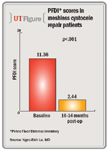Article
Meshless cystocele repair shows promise
A new meshless cystocele repair procedure intended to circumvent the problems seen with traditional repair appears to be durable and cost effective.

Key Points
Los Angeles-A new meshless cystocele repair procedure intended to circumvent the problems seen with traditional repair appears to be durable and cost effective, say researchers from the UCLA David Geffen School of Medicine.
At the date of the presentation of preliminary findings at the 2011 AUA annual meeting in Washington, only one of 72 patients in the study had developed a major complication at roughly 2 years' follow-up.
"We use an aspect of traditional repair-mattress sutures-to plicate the central defect. The novel part of this procedure is that we add four lateral sutures to the obturator fascia that will be interlocked with the central sutures to a supporting net of non-absorbable sutures. The idea is that it provides lateral and central defect repair without mesh," first author Ngoc-Bich Le, MD, told Urology Times.
The procedure, called Cystocele Repair using Interlocking Sutures of Polypropylene (CRISP), was developed in response to a high frequency of recurrence the department was seeing in traditional repairs.
"The problem with using native tissue is that a lot of patients have recurrence within 4 years of surgery. We were battling between durability of cure and complications of cure," Dr. Le said.
"The take-home message is that we have an alternative for cystocele repairs which at this point in time has demonstrated anatomic and symptomatic improvement. And this is achieved while avoiding the complications associated with mesh. We can say that at 2 years, it has been a durable repair."
Dr. Le said the drive to create a new procedure was given additional impetus by the 2008 release of an FDA warning about complications associated with surgical mesh for prolapse. (The FDA issued a second warning in 2011 citing many of the same problems: pain, infection, bleeding, pain during sexual intercourse, organ perforation, urinary problems, recurrent prolapse, and others. In this second warning, the FDA said it had received a total of 2,874 reports of complications from January 2008 through December 2010, of which 1,503 were associated with prolapse repairs.)
Symptomatic improvements observed

Dr. Le said it is too early to offer firm conclusions on the efficacy of the procedure, but the findings are encouraging.
"In the standard procedure, approximately 30% of the patients will require a secondary procedure. If we found that there is significant durability [in the CRISP procedure] at about 5 years, then we would feel that we have sufficient data to support what we are doing," Dr. Le told Urology Times.
The one patient with a complication to date presented with a ureteric obstruction that was treated endoscopically. Cystoscopy must be done at the time of the procedure after intravenous injection of indigo-carmine to make sure that the ureters are patent.
Newsletter
Stay current with the latest urology news and practice-changing insights — sign up now for the essential updates every urologist needs.















